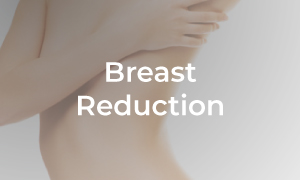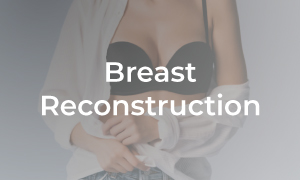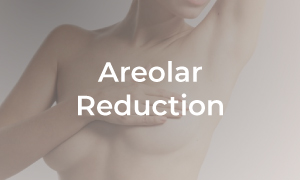Breast Reduction
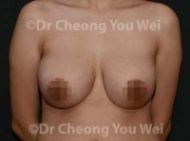

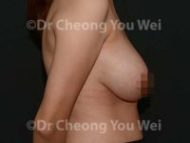
Before
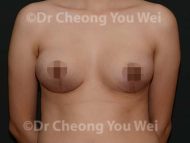


After
Breast reduction surgery(also known as reduction mammaplasty) removes excess breast tissue, fat and skin to create a smaller, more proportionate breast.
Women with very large breasts often suffer chronic neck, shoulder and back pain, skin rashes or infections under the breast folds, and posture problems. Studies have shown that reduction mammoplasty can relieve pain in the upper back, neck and shoulders and improve ability to exercise, significantly improving activity and quality of life. Many women find it easier to participate in sports and vigorous activities after breast reduction (better upper-body range of motion and no longer limited by breast size). Besides reduction of breast size, the saggy large breasts are reshaped to be perkier and more proportional to the body. Clothing and bras fit more comfortably, and women can wear a wider variety of styles. Many also note improved symmetry between breasts. Breast reduction often produces marked improvements in self-esteem and body image. Patients report feeling less self-conscious and more confident in social and intimate situations . Psychosocial well-being and mental health scores improve substantially postoperatively.
Preparation for Surgery
-
Medical Conditions and Allergies: Inform your doctor of any pre-existing medical conditions or drug allergies. All medical conditions must be properly treated and stabilised before surgery.
-
Smoking (including vaping): Stop smoking at least one week before surgery. Smoking impairs wound healing and significantly increases the risk of post-operative complications.
-
Medications and Supplements: Discontinue the following one week before surgery and continue avoiding them until one week after surgery:
-
Supplements: Avoid all supplements containing vitamin E, ginseng, ginkgo, garlic, fish oil, or any other substances that may increase bleeding. Stop any traditional medicine or herbal remedies with unknown ingredients
-
Medications: Medications that may increase bleeding—such as aspirin, NSAIDs, and warfarin—should also be stopped. However, please consult your prescribing physician before discontinuing any medication.
-
-
On the day of surgery: wear simple and comfortable clothing. Do not wear any makeup, jewellery and metal objects on your face and body.
Surgery Overview
Duration: 3-4 hours
Anaesthesia: General Anaesthesia
Hospitalization: One day
Surgery Technique:
Breast reduction surgery involves making incisions around the areola, and usually vertically down to the breast crease, sometimes with a horizontal incision in the crease. Through these incisions, the surgeon removes excess glandular tissue, fat and skin, lifts and reshapes the remaining breast, and repositions the nipple-areola complex (which is still attached to its blood supply) to a higher, more central location. Finally, the wounds are closed with layered sutures and dressings.
Different surgical techniques are available, depending on the size and shape of the breasts and the amount of tissue to be removed.
-
Vertical short scar technique (Lollipop scar):
 An incision is made around the areola, with a second vertical incision extending from the areola down to the lower edge of the breast, creating a lollipop-shaped scar. This technique produces a shorter scar compared to the Inverted-T technique and results in a more natural and uplifted breast shape. This technique is the preferred technique in our practice.
An incision is made around the areola, with a second vertical incision extending from the areola down to the lower edge of the breast, creating a lollipop-shaped scar. This technique produces a shorter scar compared to the Inverted-T technique and results in a more natural and uplifted breast shape. This technique is the preferred technique in our practice. -
Inverted T technique (Anchor scar):
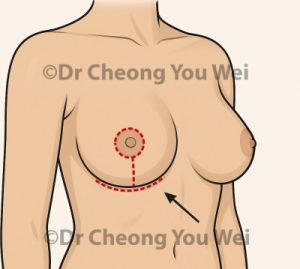 An incision is made around the areola, a vertical incision is made down to the breast fold, and a third horizontal incision is made along the lower breast crease. This technique produces the most scarring among all techniques and is best suited for very large breasts requiring extensive tissue removal.
An incision is made around the areola, a vertical incision is made down to the breast fold, and a third horizontal incision is made along the lower breast crease. This technique produces the most scarring among all techniques and is best suited for very large breasts requiring extensive tissue removal. -
Periareolar reduction: A single circular incision is made around the areola. This technique leaves minimal visible scarring but is only suitable for minor reductions where a small amount of tissue is removed.
-
Liposuction-only reduction: In carefully selected patients—particularly those with breasts that are mostly composed of fatty tissue—liposuction alone may be an effective method to reduce breast size. This technique involves making a few small puncture incisions through which a cannula is inserted to suction out excess fat. It results in minimal scarring and no large skin incisions. However, liposuction-only reduction is suitable only if the breasts are moderately large, the tissue is primarily fatty rather than glandular and there is only mild skin laxity or redundancy. It is not appropriate for patients with significant glandular tissue or excess sagging skin, as it does not remove skin or reshape the breast.
Post-operative Instructions
What to expect:
1. Swelling is normal and typically peaks around the second to third day post-surgery, gradually improving thereafter.
2. After the procedure, your breasts will be dressed and supported with either a surgical bra or elastic bandages to help reduce swelling and provide support during healing.
3. In some cases, small surgical drains may be placed for 1–2 days to remove excess fluid and minimize the risk of fluid accumulation.
4. Showering is usually permitted 2–3 days after surgery, but you should take care to keep the dressings dry and avoid soaking the surgical area.
General care:
-
-
Wear a special supportive bra: Use a special supportive bra continuously for at least one month to aid healing and provide proper support
-
Avoid smoking. Refrain from smoking for at least one month, as it significantly increases the risk of wound healing complications.
-
Sleep on your back. Avoid sleeping on one side to prevent pressure on the breast.
-
Get adequate rest — Ensure you get enough rest and quality sleep to promote a faster and smoother recovery
-
Stay calm and relaxed — Keeping a relaxed and positive mindset helps your body heal. If you have any questions or concerns, don’t hesitate to contact the clinic.
-
Medicine instructions: Complete the antibiotics — Finish the full course of oral antibiotics as prescribed, even if you feel well. Pain management — Take the prescribed painkillers when necessary, as directed
Wound care instructions:
1. Keep the dressing on — Leave the wound dressing in place until your scheduled review at the clinic.
2. Change if necessary — If the dressing becomes dirty or soaked, replace it with a clean one.
3. After dressing removal — Once the dressing is removed (as advised by your doctor), gently clean the wound using a clean cotton tip soaked in sterile water or saline.
4. Apply ointment — After cleaning, apply antibiotic ointment as directed.
Physical activity instructions: Limit arm motion and avoid lifting heavy objects. Avoid heavy physical activity and strenuous exercise for at least one month to allow proper healing
Follow-up instructions: Return to the clinic one week after surgery for your follow-up appointment and wound assessment.
Emergency instructions: If there is heavy bleeding, a rapid increase in swelling or severe pain, contact the clinic/doctor for advice immediately.
Recovery milestones ( the actual recovery speed may vary from person to person):
Week 1: Rest at home. Expect bruising, swelling and tenderness around the breasts (take prescribed pain medication as needed). Continue wearing the compression bra. Showering may be possible a few days post-op; follow the surgeon’s guidance on wound care and dressings. Limit arm motion and avoid lifting or strenuous activity .
Weeks 2–3: Many patients feel substantially better. Stitches (if non-absorbable) may be removed. Swelling and bruising start to subside. Light daily activities and desk work can often be resumed (depending on comfort). Still need to avoid heavy lifting or vigorous exercise.
Weeks 4–6: Support bra should still be worn (especially during exercise). Patients generally may begin gradually increasing activity and light exercise (no upper-body weightlifting) as approved by the doctor. Swelling continues to improve.
6+ Weeks: By this point most women can return to full normal activities, including sports, though full healing (resolution of all swelling and scar maturation) continues over 6–12 months. Scar massage or silicone treatments may be recommended once wounds are healed to help flatten scars.
3–6 Months: Final shape continues to refine. Scars gradually fade and soften. In the first few months after surgery, the breasts may appear firm or high with a fuller upper pole, which can look unnatural. This is a normal part of the healing process. Over the course of 3 to 6 months, the breasts will gradually settle into a more natural and balanced shape
Please Note:
These instructions are meant for general guidance only. If you have any specific questions or concerns during your post-operative recovery, please contact the clinic directly for further advice.





